Whilst there appear to be some subtle cultural differences in some aspects of visual perception, it is also worth reminding ourselves that in terms of perception we have far more in common with the rest of the human species than with the rest of the animal kingdom. However, in addition to cultural differences, certain individual differences can affect our visual perception - quite apart from physiological differences such as impairment of sight. People differ, for instance, in spatial skills (e.g. 'mental rotation' - competence in mentally rotating 3D shapes so as to assess them from another angle).
In a well-known experiment by Asch (1955), one subject was seated in a room with six other people. Unknown to the subject the other people were confederates of the experimenter. The experimenter told the group that accuracy of perception was the focus of the study. The group was then shown two cards (see illustration below). On one card was a single vertical line and on the other there were three vertical lines of markedly different lengths, one of which being the same as the one on the other card. The group was told that each individual should match the line on the first card with one of the lines on the other card. There were eighteen trials with different lengths of lines on the second card. In each trial the real subject was second from last in being asked for a response, thus hearing five other people each time offering their own answers. In the first two trials the confederates all gave the correct answer but they only did this four times in the following trials - in the other twelve trials they were all primed to give the same wrong answer. About a quarter of the subjects stuck to their own judgement and gave the correct response. The rest accepted the majority verdict at least some of the time. This would suggest that conformity may sometimes influence perception.
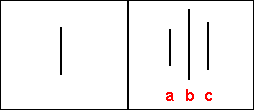
Some factors related to personality may have an influence on perception. One such factor is 'tolerance of ambiguity' (a term employed by Else Frenkel-Brunswik). In 1951, two psychologists called Block reported an experiment in which subjects were placed in a dark room where only a point of light was visible. Since they had nothing else to go by, all of them saw the light sway in various directions. However, some reported the light as moving in a constant direction from trial to trial and to a constant number of inches. Such people have been described as having a low 'tolerance of ambiguity': they require more stability than most, and quickly tend to manufacture it in situations of ambiguity. Other people tend to take longer to establish such a norm: they have a high tolerance of ambiguity.
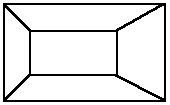
Another experimenter, Fisher, reported in the same year comparing people classified as having high or low prejudice. He briefly showed both groups a picture of a truncated pyramid (see below) and then asked them to draw it from memory. About 40% of people tended to draw it as symmetrical, equalizing the two margins of the drawing. This is quite usual, since memory simplifies. But after a four-week interval, 62% of the prejudiced group and only 34% of the tolerant group equalized the margins. One group seemed to need a clear and simple image much more than the other group did. Those tolerant of ambiguity seemed to favour uniqueness (for both Block & Block and Fisher see Allport 1958, 377-8).
Differences in cognitive style have implications for perception. Jerome Kagan outlined a difference in cognitive style which he referred to as impulsivity vs. reflectivity. When asked to find a match for a 'familiar figure' (such as a drawing of a telephone) from a choice of 6, some people seem habitually 'leap in' with a response before checking the alternative fully - these are the impulsives - whilst others seem unwilling to respond until they are sure that they have made the correct choice - these are the reflective types.
Another kind of cognitive style was referred to as 'field dependence or independence' by Herman Witkin. Field independence refers to an aptitude for disembedding figures from their contexts. Someone who finds words easily in word-search grids has considerable field independence. There is a current vogue for Where's Wally? books in which one has to find a recurrent character amidst a crowd of people and a frenzy of depicted activity on a very detailed double-page spread. Those who are good at this are field independent. Similarly children's puzzles sometimes include the task of identifying faces, objects or animals 'hidden' in a relatively detailed drawing (an adult equivalent sometimes uses paintings). These are of course very artificial tasks, but field independent people would be just as quick at spotting someone in a real crowd.
Gender plays a part in perception too. One gender-related influence concerns how our attention may be drawn to different aspects of a scene or image. In a study by Hess (1965) the eye-movements of a man and a woman were compared when they looked at a figurative painting by Leon Kroll called 'Morning on the Cape', featuring a bare-backed man ploughing with a horse, and two women - one in the foreground and another leaning against a tree. Both subjects began scanning the painting from almost the same point, but the location, duration and sequence of their gaze were different. Unsurprisingly, the female observer paid much more attention to the male figure in the picture than the man did, and the male observer paid more attention to the female figure in the foreground than the female observer did. The woman observer focused only on the head of the foreground woman whilst the man focused on both the head and the upper body of this female figure. The female observer did not focus on the house and field at all, whilst the man did. This direction of attention reflects conventional gender stereotypes of course.
Using ambiguous doodle-like black-and-white figures (see illustration below), Coren, Porac and Ward (1978, 413) found gender differences in interpretation. A figure which was more likely to be viewed as a brush or a centipede by males was more likely to be viewed as a comb or teeth by females. Another figure viewed as a target mostly by males was more likely to be viewed by females as a dinner plate. And a third figure which was viewed mostly by men as a head was viewed mostly by females as a cup.
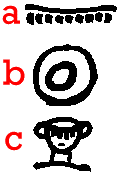
Other roles can also influence perception. An aerial photograph of a river delta may appear obvious to a geographer or a pilot, but if the image lacked an explicit label, others might have quite different interpretations. What is Corvus corax to a professional ornithologist is simply a pest to some farmers, an ill omen to the superstitious, 'Old Grandfather' to the Koyukon Indians of the subarctic forest of North America, a crow to most of us, and a raven to the amateur naturalist.
Prejudice can affect perception as Gordon Allport and Leo Postman showed in a famous study (1945). After briefly looking at a drawing of figures inside an underground train - five men, two women and a baby, with two of the men standing - a black man and a white man face-to-face in the centre of the picture. Observers were asked to describe what they had seen. Over half of the observers reported having seen a cut-throat razor in the hands of the black man. Some even claimed that he had been 'brandishing it widely' or 'threatening' the white man whereas it was actually in the left hand of the white man standing with him. This experiment was part of a study of rumour so memory as well as perception was involved.
Many factors which play a part in influencing how things are perceived are relatively 'stable' or long-term individual factors. These include personality, cognitive styles, gender, occupation, age, values, attitudes, long-term motivations, religious beliefs, socio-economic status, cultural background, education, habits and past experience. But there are other factors which may contribute to individual differences in perception which are more transitory. These include current mental 'set', mood (affective/emotional state), goals, intentions, situational motivation and contextual expectancies (Warr & Knapper 1968).
It is worth reminding ourselves that even photographs reflect not only the scene they depict but the purposes of the photographer. As Susan Sontag noted: 'photographs are as much an interpretation of the world as paintings and drawings are' (Sontag 1979, 7). A photograph is a particular photographer's selection from the world of something which they regarded as significant for some reason and is framed in a way which reflects certain considerations. Such purposes include:
- making a record of something
- aesthetic reasons - the subject and/or the framing seemed aesthetically interesting (e.g. 'beautiful')
- 'self-expression' - to express how they felt about something
- persuasion (social/political) e.g. to shock
'Nobody takes the same picture of the same thing', so 'photographs are evidence not only of what's there but of what an individual sees, not just a record but an evaluation of the world' (Sontag 1979, 88). Furthermore, each photograph alludes to photographic conventions:
- of a particular historical period
- for photographs of particular types (e.g. news photos, snapshots, portraits, passport photos)
- composition/framing, lighting, point of view
- of other photographs by the same photographer
Returning to the perception of images, a well-known study by Yarbus (1967) showed how the eye-movements of observers of pictures varied according to the questions they were asked to consider. In relation to a figurative painting showing people in a sitting room and a figure at the open door, people were asked to estimate the material circumstances of the family in the picture, to give the ages of the people in the picture, to suggest what the family had been doing before the arrival of the 'unexpected visitor', to remember the clothes worn by the people, to remember the position of the people and objects in the room, and to estimate how long the visitor had been away from the family. The pattern of eye movement and the areas on which the gaze rested in each case were markedly different.
Here is a rough idea of the painting which Yarbus's subjects were asked to look at...
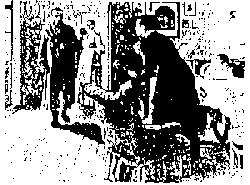
And here one recorded pattern of eye movements of an observer looking at the painting. We clearly do not scan pictures in either a random or robotic manner.
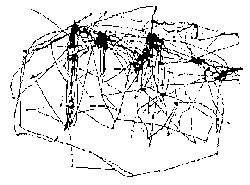
Levine, Chein and Murphy (1942) presented people with a set of ambiguous line-drawings and asked them to describe what they saw. One group was hungry whilst the other group had just eaten. The ones who were hungry more often perceived food items in the ambiguous drawings than those who had just had a meal. Current needs can thus affect perception.
In a well-known experiment conducted by Jerome Bruner and Cecile Goodman (1947), two groups of children were asked to judge the size of coins. One was a poor group from a slum area in Boston and the other was an affluent group from the same city. The poor group over-estimated the size of the coins far more than did the affluent group. Thus social values and individual needs can influence perception.
Dannenmaier and Thumin (1964) asked 46 nursing students to estimate the heights of the Assistant Director, their instructor and two fellow-students. The researchers found a relationship between perceived status and estimated height. Those in authority were judged to be taller than they actually were, whilst those in lower status were judged to be shorter. Memory as well as perception may have played a part here. Perceived size was clearly related to the importance ascribed to the people perceived in this experiment.
Thematic Apperception Test (TAT) cards are sometimes used in psychoanalysis as a way of exploring the thoughts and feelings of the person interpreting the ambiguous but figurative situational images depicted on the card. The scenes depicted are emotionally charged but open to interpretation in a variety of ways. The use of such images acknowledges the role of personal concerns in perception.
Mood may also influence perception. Leuba and Lucas (1945) conducted an experiment involving the description of 6 pictures by 3 people when in each of 3 different moods. Each mood was induced by hypnosis and then the pictures were shown. Here are the descriptions that one person gave for a picture of 'four college men on a sunny lawn, listening to radio':
- Happy mood: 'Complete relaxation. Not much to do - just sit,
listen and relax. Not much at all to think about.'
- Critical mood: 'Someone ruining a good pair of pressed pants
by lying down like that. They're unsuccessfully trying to study.'
- Anxious mood: 'They're listening to a football game or world
series. Probably a tight game. One guy looks as if his side wasn't
winning.'
We need to remind ourselves that it was the same picture each time. Mood can clearly play an important part in perception.
Albert Hastorf and Hadley Cantril (1954) conducted what became a famous study of the reactions of opposing fans to an American football game between two university teams - the Princeton Tigers and the Dartmouth Indians (Princeton won). It was a rough and tense game. One Dartmouth player was taken off with a broken leg and a star Princeton player suffered a broken nose. Both sides were penalized. Undergraduate students from each of the universities were asked for their reactions to the game a week later.
69% of the Princeton students who had seen the game saw it as 'rough and dirty' compared to only 24% of the Dartmouth supporters, whilst 25% of the Dartmouth students invented their own category of 'rough and fair'. When shown a film of the game later, the Princeton students 'saw' the Dartmouth team make over twice as many rule infractions as were seen by Dartmouth students. Hastorf and Cantril comment that:
-
The data here indicate that there is no such 'thing' as a 'game' existing
'out there' in its own right which people merely 'observe'. The game
'exists' for a person and is experienced by him only insofar as certain
happenings have significances in terms of his purpose.
For these students, the perception and recall of what might seem to be 'the same event' involved a very active construction of differing realities. Hastorf and Cantril's classic case-study emphasizes the crucial role of values in shaping perception.
-
Visual Perception 1: Searching for Patterns
-
Visual Perception 2: The Third Dimension
-
Visual Perception 3: Selectivity and Perceptual Constancy
-
Visual Perception 4: Cultural and Environmental Factors
-
Visual Perception 5: Individual Differences, Purposes and Needs
-
Visual Perception 6: Context and Expectations
-
Visual Perception 7: Gestalt Principles of Visual Organization
-
Visual Perception 8: The Moving Image
-
References and Suggested Reading

|